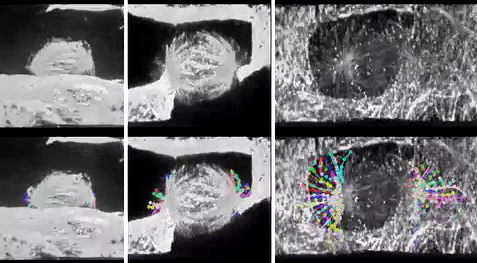|

CLICK ON weeks 0 - 40 and follow along every 2 weeks of fetal development
|
||||||||||||||||||||||||||||
|
Developmental biology - Cell Division Why do we need a pair of genome? In normal cells there are two centrosomes that regulate cell replication. Researchers saw that gradual loss of centrosomes in haploid cells, and frequent duplication of centrosomes in tetraploid cells, trigger abnormalities in cell replication. "Incompatibility between the centrosome duplication and the DNA replication cycle could be the underlying cause of the instability in non-diploid cells - such as cancer cells - in mammals. Our findings could help us understand chromosome instability in cancer cells, which are often in a non-diploid state, and lead to new cancer treatment strategies." explains Ryota Uehara, PhD. Abstract In animals, somatic cells are usually diploid and are unstable when haploid for unknown reasons. In this study, by comparing isogenic human cell lines with different ploidies, we found frequent centrosome loss specifically in the haploid state, which profoundly contributed to haploid instability through subsequent mitotic defects. We also found that the efficiency of centriole licensing and duplication changes proportionally to ploidy level, whereas that of DNA replication stays constant. This caused gradual loss or frequent overduplication of centrioles in haploid and tetraploid cells, respectively. Centriole licensing efficiency seemed to be modulated by astral microtubules, whose development scaled with ploidy level, and artificial enhancement of aster formation in haploid cells restored centriole licensing efficiency to diploid levels. The ploidy–centrosome link was observed in different mammalian cell types. We propose that incompatibility between the centrosome duplication and DNA replication cycles arising from different scaling properties of these bioprocesses upon ploidy changes underlies the instability of non-diploid somatic cells in mammals. Authors: Kan Yaguchi, Takahiro Yamamoto, Ryo Matsui, View ORCID ProfileYuki Tsukada, Atsuko Shibanuma, Keiko Kamimura, Toshiaki Koda, Ryota Uehara. Acknowledgements This research was supported by the UC San Francisco California Preterm Birth Initiative, which is funded by Marc and Lynne Benioff. Additional support was provided by grants from the National Institute of Environmental Health Sciences (K99ES027023, P01ES022841, R01ES027051) and the U.S. Environmental Protection Agency (RD-83543301). Return to top of page | Jun 14, 2018 Fetal Timeline Maternal Timeline News News Archive  and microtubules (green) in cell division 5005.jpg) A diploid cell (LEFT) and A haploid cell (RIGHT) showing normal and abnormal orientation of chromosomes (PURPLE) with microtubules (GREEN) during cell division. Image credit: Yaguchi K., et al., Journal of Cell Biology.
|
||||||||||||||||||||||||||||


